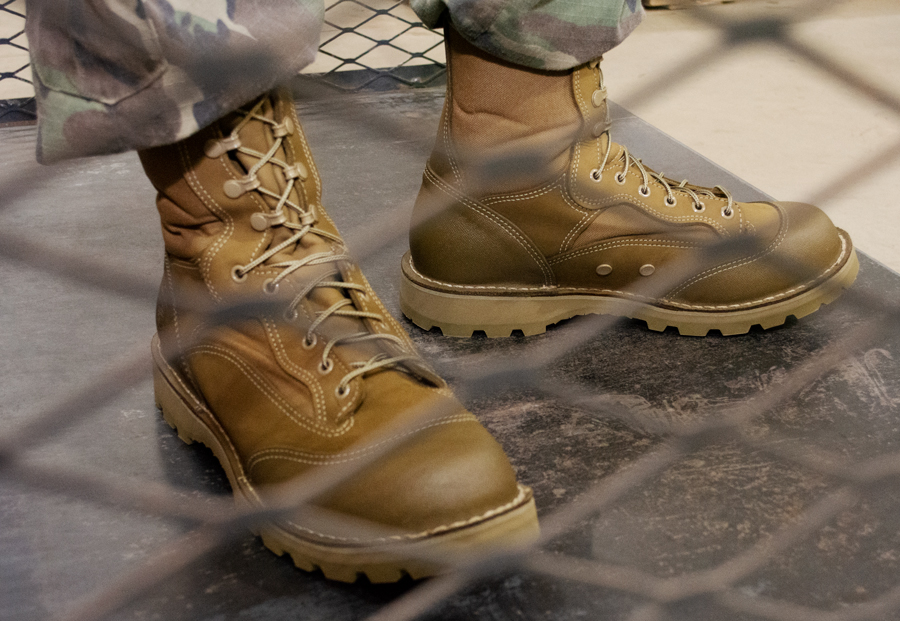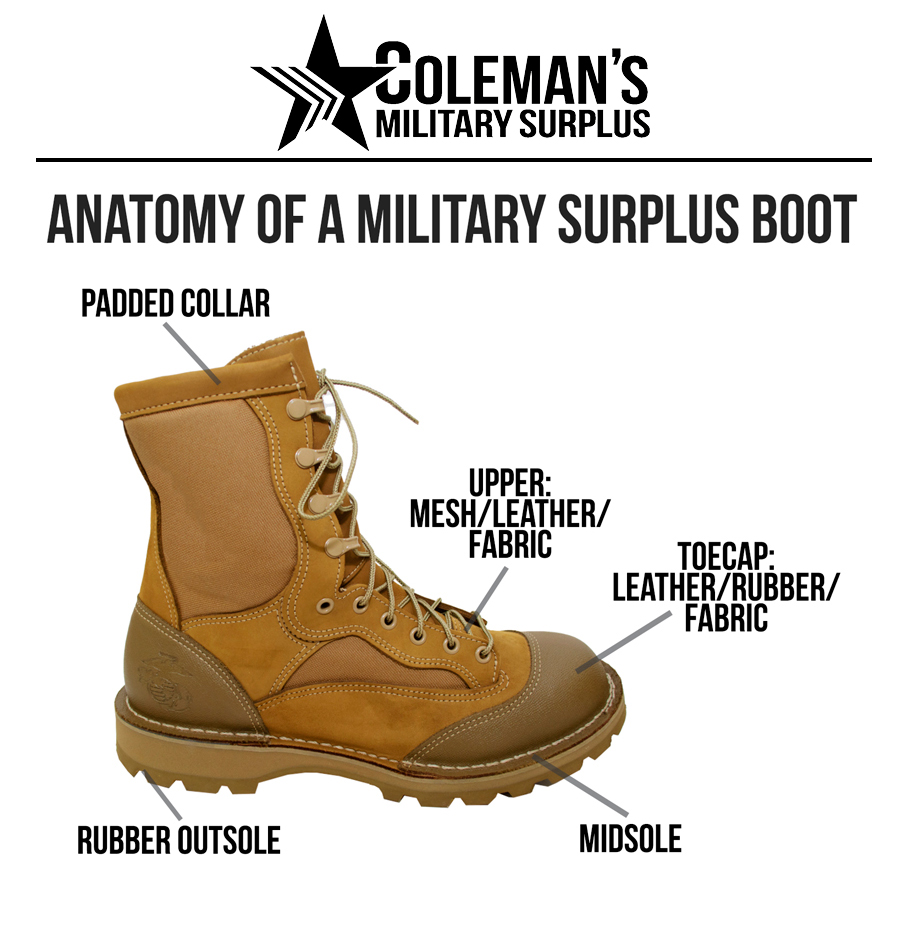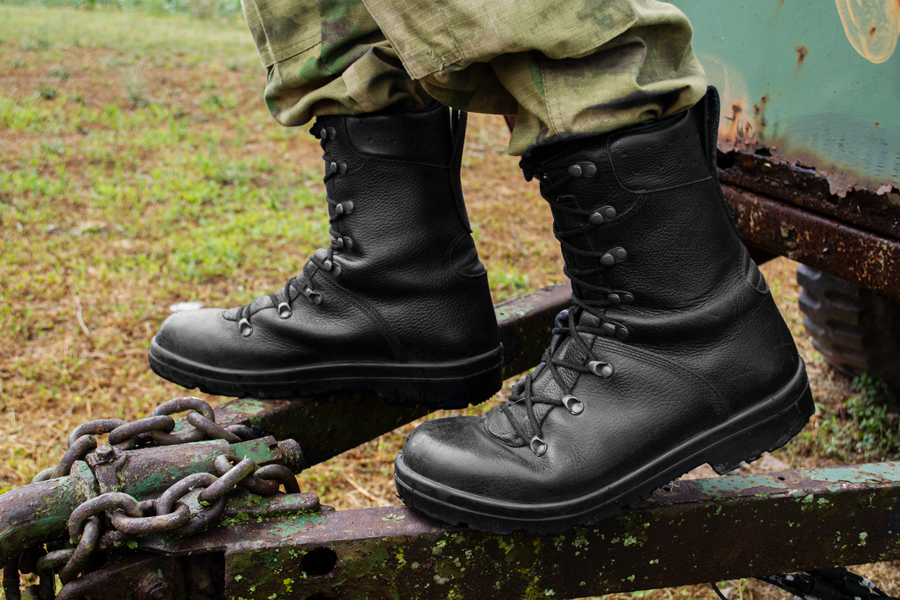Choosing Surplus Boots & Footwear


Durability
As it is highly applicable to the wearer's habits, usage, and time spent in their boots, no one can promise their footwear will assist you carry out heavy-duty tasks without replacing any parts of it. They are durable but not indestructible.
According to our customer reviews and comments, we found out the commonality of durable military surplus boots are usually made from leather, nylon, or both. We know that top-grain leather offers the best durability in the field and flexibility of usage during inclement conditions.
Anti-Slip

The boots' gripping power depends on the outsole pattern, as they can be designed in triangles, squares, hexagons.
To create even better traction, choose an outsole designed with small notches that divide the tread shape into a few parts. These snipes transport more fluid material to the outer portion of the outsole, increasing the anti-slip effect.
Taking into account that outsole tread depth is reduced by wear (varying on the surface you usually walk on), you should examine from time to time and replace the boots if they are no longer able to provide a reasonable slip-resistant effect.
Lightweight

Our users are likely spending very long hours a day in their boots, and hence extra weight can drag an operator down while engaging vigorous movement or action in the field. Lightweight boots use materials that are naturally light or adaptable in the manufacture method. Many lightweight purposeful boots are made of nylon upper. This man-made polymer fabric is also breathable to provide extra comfort.
Waterproof or Water-Resistant?
When shopping for durable and functional footwear, it’s crucial to consider the environment in which you’re operating and or live, and the essential elements that you require from your equipment and clothing gear. The difference between waterproof and water-resistant clothing is small, but crucial. We’re here to help you understand the two, as well as when each option is most suitable and fitted to your adventures.
Breathability
As operators are usually wearing thick socks and their feet are stuffed inside the boots for very long hours, the breathability of boots is another main concern for them.
There is a trade-off between water resistance and breathability of your footwear; the better the boots keep your feet dry when immersing in water, the worse their breathability is as they prevent not just water, but air flows, too.

What is Deemed a Good Fit?
When walking on flat ground, angled and uneven terrain, you should check whether the boots fulfill your requirements and find your perfect fit. Appropriate fitting of a pair of boots draws upon two important areas of consideration: length and width. When fitting a pair of boots, the space between the ends of the big toe of the boot should be the width of the thumb and there should be sufficient space under the lower edge of the tongue to admit an index finger in an unlaced boot
Your entire foot should feel snug EXCEPT for your heel. The slippage will disappear when you've broken in the boot. If you are feeling too much slippage, the problems usually lie in...
- The boot is not broken in.
- The boot is not laced tight enough.
- The boot is too high for you. You can put in a tongue pad to balance for height.
- The boot is too long for you. You can insert a heel grip to fix it.
- The widest part of your foot needs to be at the widest part of the boot. Most boots come without arch support, but you can get some orthodontic insoles if you have flat feet.
- Have a bit of wiggle room for your toes in the front of the boots. If you can fit in your finger in the space between your longest toe and the tip of the toe cap, it is judged a good fit; but if you have a little extra space in your toe cap and the rest of the parts fit perfectly, you should keep it that way instead of sizing down.
- Wear thick socks when trying on the boots. Most boots are fabricated to be worn with padded thick socks (with extra padding at heel and toe areas), they are also to safeguard you from blisters and hotspots. Select socks made from wool as it is moisture-absorbing, keeping your feet warm in cold, breathable, quick-drying, anti-bacterial, and odor resistant.
How to Break-In Your Boots?

According to survival professionals, most military boots will stretch by only about a millimeter, even with a boot stretcher. It is necessary to break-in your boots for your boots to take the shape of your foot to avoid blister, calluses & corns, hammertoe, and more foot pains that could affect your survivability while deployed in the field.
Extra Tip
It’s not a bad idea to get two pair so you can rotate days and allow one pair to totally dry out while you wear the other pair. "Two is one and one is none." This idea simply underlines the significance of always preparing a backup ground plan. That having one of something is like having none at all and that having two of anything is the same as what you consider having one.
You can also visit Choosing Surplus Boots & Footwear






Comments